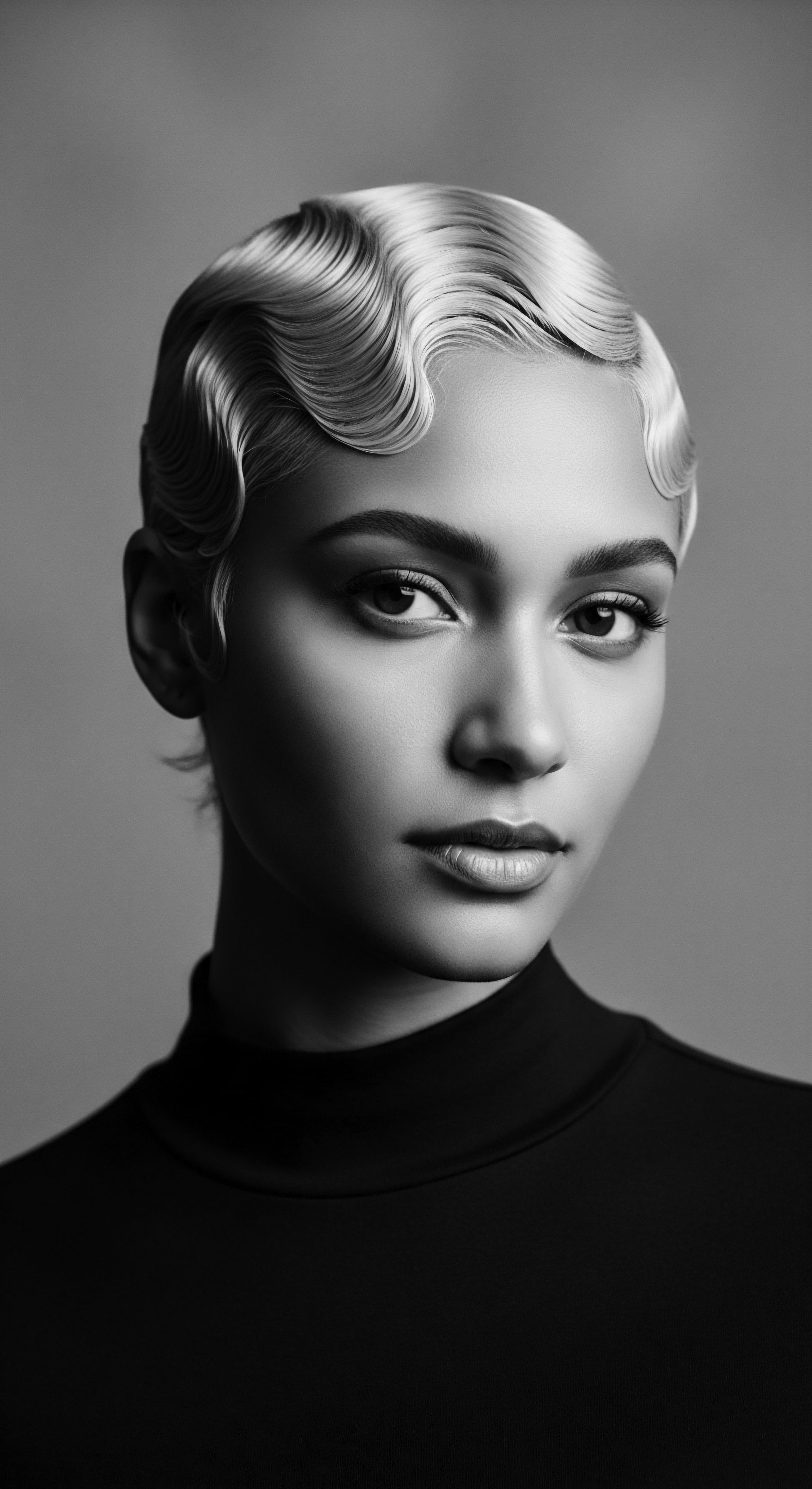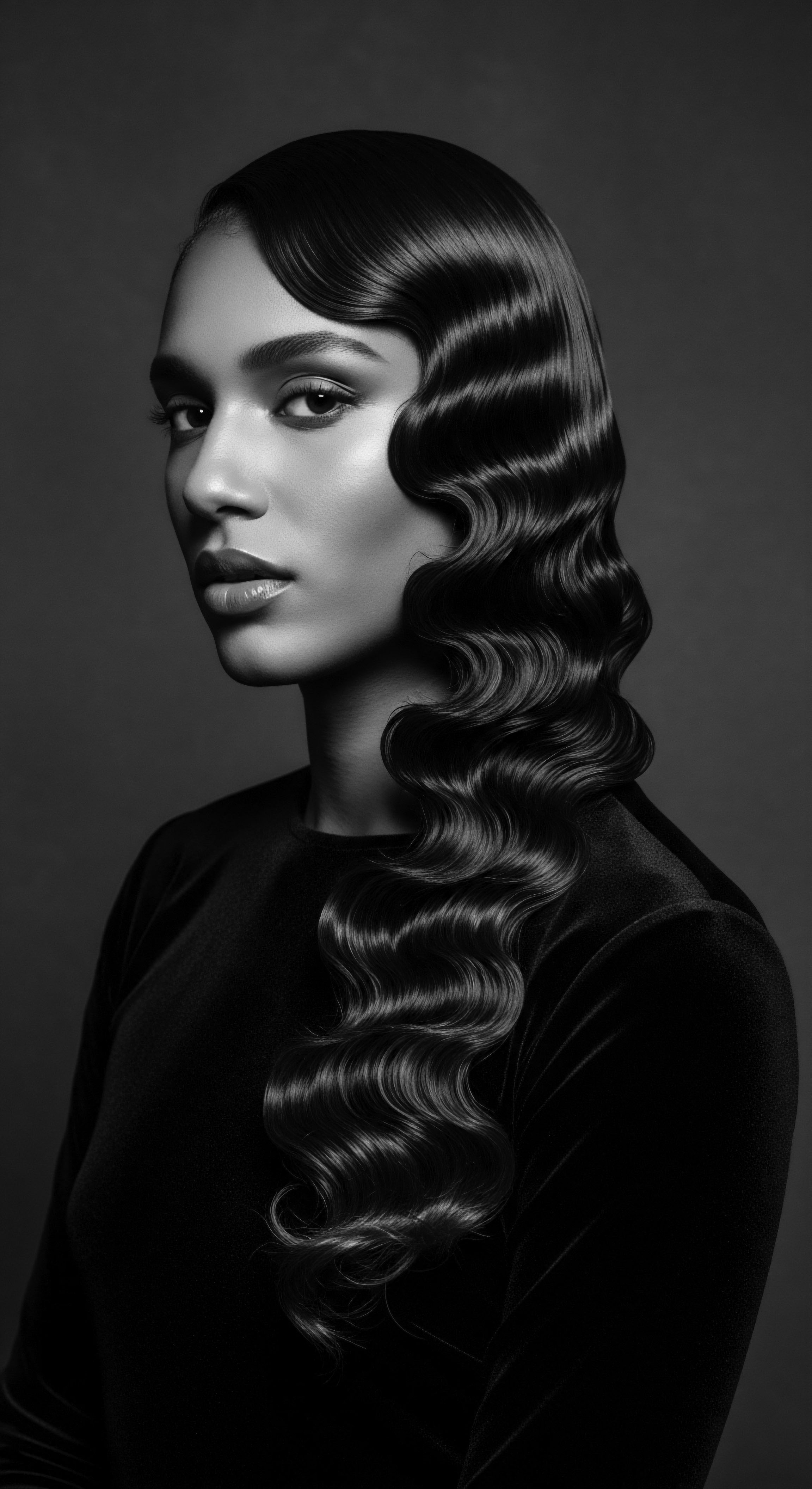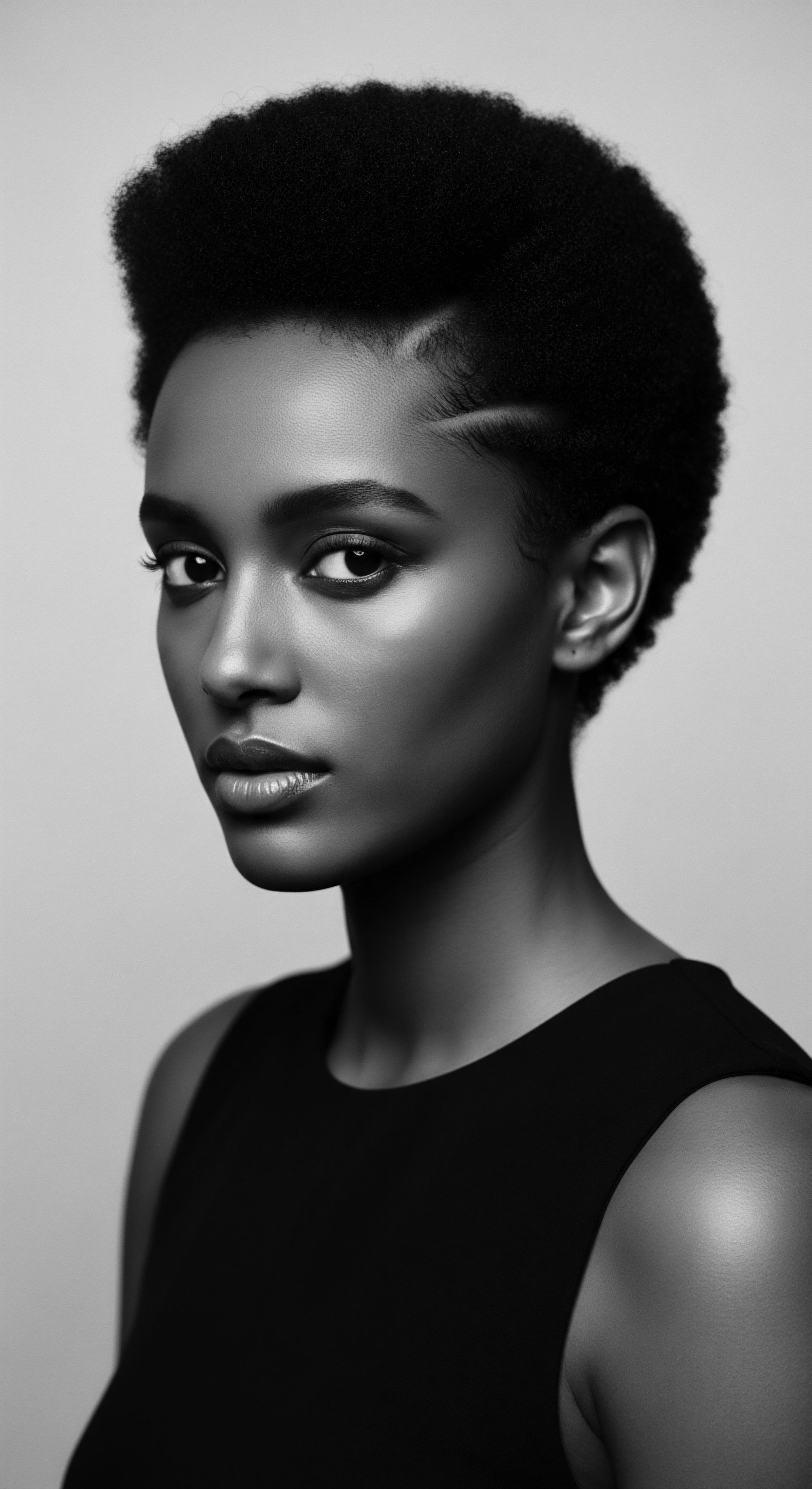
Roots
There are whispers that curl through the very fabric of our being, soft as the nascent spiral of a new hair strand, yet resonant with the weight of centuries. These whispers speak of hair, not as mere adornment, but as a living archive, a scroll upon which generations have written their stories, their resilience, their sorrows, and their triumphs. For those who carry the inheritance of textured hair, this connection is particularly profound. It is a lineage etched into every twist, every coil, every wave.
The enduring hold of certain historical beauty ideals upon these diverse crowns is not a simple matter of fleeting fashion or personal preference. Instead, it traces its roots deep into the shared soil of history, culture, and the very biological distinctions that once marked sacred identity, only to be twisted into instruments of subjugation.
To truly grasp why historical beauty standards, often antithetical to the inherent glory of textured hair, continue to echo in our present, we must first look to the elemental. The strands that crown us are not uniform across humanity’s vast expanse. The architecture of a kinky coil, a tightly sprung curl, or a flowing wave holds within it distinct properties. Consider the elliptical follicle from which highly textured hair emerges, shaping a strand that is not perfectly round but flattened, almost ribbon-like in cross-section.
This unique geometry means that as the hair grows, it twists and turns upon itself, creating the characteristic spirals and zigzags that define its beauty. The cuticle, the hair’s protective outer layer, lifts and separates more readily at these bends, presenting a surface with greater friction and a natural inclination towards what some call “dryness,” though it is truly a different kind of moisture management than straight hair requires. This understanding, that the very structure of the hair dictates its needs and behaviors, was not lost on our forebears. They observed, they learned, and they devised practices that worked in profound concert with this natural design.

What does Hair’s Elemental Design Mean for Its Ancestral Care?
Long before microscopes revealed the secrets of the hair shaft, ancestral communities across the African continent possessed an intimate understanding of textured hair’s nature. Their practices were not born of scientific treatises but of observation, necessity, and a deep reverence for the human form and its connection to the natural world. Hair was a conduit to the divine, a symbol of tribal belonging, marital status, age, wealth, and spiritual power. In many West African societies, for example, elaborate hair designs communicated complex social codes, functioning as a non-verbal language within communities.
These traditional forms of care and styling recognized the hair’s inherent need for protection, moisture, and gentle manipulation. The coiling patterns, often misinterpreted as fragile by Western standards, were in fact celebrated for their strength, their ability to hold intricate styles, and their symbolic resilience. This heritage of care, steeped in a practical knowledge of the hair’s true biological needs, formed the bedrock of identity for countless generations.
The naming conventions for hair, too, varied greatly across these cultures, each term carrying specific meanings and cultural significance. The very act of hair styling was a communal event, a tender thread connecting generations. Grandmothers, mothers, and aunties would share ancient secrets for preparing natural ingredients—butters, oils, herbs—that nourished the hair from root to tip.
These ancestral lexicons, often oral, described not just textures but the spiritual properties and social roles hair held within community life. The concept of “good hair,” so pervasive in later colonial contexts, had no place in these traditions; all hair, in its myriad forms, was good, sacred, and meaningful.
The intrinsic biological properties of textured hair informed a rich tapestry of ancestral practices that revered its unique nature, laying a foundation of heritage rooted in self-acceptance.
The imposition of different beauty standards arrived with colonial expansion, disrupting this harmonious relationship. European ideals of beauty, centered on long, straight, or gently wavy hair, were intrinsically linked to racial hierarchies. Textured hair, once a source of pride and a marker of diverse heritage, became pathologized, labeled as “bad,” “unruly,” or “unprofessional.” This was a deliberate act of cultural diminishment, designed to strip away identity and enforce conformity.
The language used to describe textured hair shifted from terms of reverence and cultural significance to those laden with negative connotations, reflecting the colonizer’s gaze. The very anatomy of the hair, celebrated for millennia, was reframed as a flaw, requiring alteration or concealment.
This historical redefinition of beauty, particularly in the context of chattel slavery and subsequent systemic oppression, played a critical role in how textured hair was perceived and treated for centuries. Enslaved Africans were often forced to shave their heads upon arrival, a violent severing of cultural ties and individual identity. Later, as they navigated a world that denied their humanity, the adoption of European hair standards became a precarious pathway to perceived social acceptance, even survival.
This legacy, born from a desire for control and a forced cultural assimilation, is a persistent undercurrent in the modern struggle for hair liberation. The deep grooves cut by these historical experiences continue to guide perceptions, making the journey to reclaim and honor textured hair heritage an act of profound cultural and personal defiance.

Ritual
The echoes of historical beauty standards resonate not merely through perception, but through the very rituals of hair care and styling that have been passed down, adapted, and sometimes, painfully, adopted. For generations, the hands that tended textured hair performed acts steeped in a heritage of knowledge, acts that were simultaneously practical, social, and deeply spiritual. These rituals, whether the careful detangling, the precise parting for braids, or the application of nourishing balms, spoke to a profound understanding of the hair’s delicate architecture and its need for specific handling. Yet, the persistent pressure of dominant beauty ideals has, at times, twisted these sacred rituals into routines of alteration and conformity.

How Did Ancestral Styling Practices Become Forms of Cultural Preservation?
Across various African societies, hair styling was a sophisticated art form, deeply interwoven with daily life and significant life events. Styles were not static; they evolved with age, marital status, social standing, and ceremonial occasions. The art of braiding, for instance, holds ancestral roots spanning thousands of years, with archaeological evidence pointing to its antiquity. These styles, often intricate and time-consuming, were protective by nature, minimizing manipulation and exposure to environmental elements, thus supporting hair health.
Tools, crafted from natural materials like bone, wood, or even thorns, were designed to work with the hair’s natural curl pattern, not against it. Palm oils, shea butter, and various herbal infusions were staple ingredients, their properties understood through centuries of empirical observation and passed down through oral traditions.
The passage of the Tignon Laws in Louisiana in 1786 offers a poignant historical example of how dominant beauty standards sought to suppress the visual expression of textured hair heritage. These laws mandated that free women of color in New Orleans wear a tignon, a headscarf or handkerchief, to cover their hair, particularly their elaborate, often celebrated hairstyles. The intent was to signify their lower status in society and distinguish them from white women, whose uncovered hair was a mark of privilege and beauty. However, in an act of powerful defiance, many free women of color transformed the tignon itself into a symbol of pride and creativity.
They adorned their tignons with jewels, ribbons, and feathers, tying them in elaborate ways that still drew attention and asserted their unique identity and cultural richness. This historical episode demonstrates how an oppressive beauty standard, designed to diminish, was met with ancestral ingenuity and transformed into an act of enduring visible heritage. (Garb, 1999)
| Ancestral Practice/Tradition Intricate braiding and protective styles signifying status and identity. |
| Colonial Impact/Dominant Standard Forced head shaving during enslavement; later, pressure to straighten hair for social acceptance. |
| Ancestral Practice/Tradition Use of natural oils, butters, and herbs for nourishment and health. |
| Colonial Impact/Dominant Standard Introduction and promotion of chemical relaxers and hot combs to achieve Eurocentric textures. |
| Ancestral Practice/Tradition Communal hair care rituals as bonding and knowledge transfer. |
| Colonial Impact/Dominant Standard Individualized, often secretive, practices of hair alteration driven by shame or desire for conformity. |
| Ancestral Practice/Tradition Hair as a spiritual conduit and connection to lineage. |
| Colonial Impact/Dominant Standard Pathologization of textured hair as "unruly," "nappy," requiring "taming." |
| Ancestral Practice/Tradition The colonial gaze systematically devalued ancestral hair practices, yet the spirit of these traditions often found new forms of expression and persistence. |

How Did the Tools of Alteration Become Embedded in Styling Practices?
With the transatlantic slave trade and subsequent colonial enterprises, a stark shift occurred. Enslaved people and their descendants, stripped of their cultural touchstones, found themselves in environments where their natural hair was not only misunderstood but actively condemned. The hot comb, introduced in the late 19th and early 20th centuries, and later chemical relaxers, presented a means to achieve the smooth, straight texture deemed beautiful and acceptable by the dominant society.
These tools and chemical processes, while offering a semblance of conformity and sometimes economic advantage, came at a cost ❉ damage to the hair, scalp, and often, psychological well-being. The persistent desire for straight hair, driven by a legacy of systemic racism and discrimination, meant that these often harmful practices became deeply entrenched rituals, passed down through generations not as acts of cultural preservation, but often as acts of survival or aspiration within a hostile framework.
Yet, amidst this, the spirit of ancestral wisdom persevered. Even as hot combs sizzled and chemicals straightened, elements of traditional care found their way into these new routines. The deep conditioning treatments, the meticulous parting for braids beneath wigs, the nighttime wrapping rituals—these were often adaptations of practices rooted in a heritage of nurturing, now applied in a complex dance between desired conformity and inherent health.
The widespread use of bonnets and head coverings for sleep, for example, descends from practices that protect intricate styles and maintain moisture, echoing ancient traditions of hair preservation. This continuation, sometimes subtle, sometimes overtly defiant, is a powerful illustration of how the heritage of care, once established, finds pathways to endure.
The journey from the collective, reverent styling of ancestral times to the often solitary and sometimes painful routines of modern hair alteration is a testament to the persistent reach of historical beauty standards. It reveals how practices born of oppression can become normalized, even ritualized, within communities, creating a complex relationship with one’s own heritage. However, the current resurgence of natural hair movements is a conscious return to and celebration of these ancient rituals, reclaiming them not as acts of survival, but as acts of self-love, cultural pride, and a vibrant reconnection to the deep legacy of textured hair.

Relay
The journey of textured hair, from revered ancestral symbol to stigmatized trait and now, increasingly, to a celebrated emblem of identity, is a complex relay race across centuries. The baton of beauty standards, once wielded by colonizers to diminish, continues to be passed down through societal norms, media representations, and even interpersonal interactions. The question of why these historical beauty standards persist for textured hair delves into the deep currents of societal conditioning, the psychology of identity, and the enduring power of economic and cultural systems that have benefited from their enforcement. It speaks to a legacy that touches every aspect of the Black and mixed-race experience, making the act of wearing one’s hair naturally a statement of profound cultural and personal affirmation.

How does Systemic Discrimination Reinforce Historical Hair Standards?
The persistence of these beauty standards is not an accident; it is deeply interwoven with systemic discrimination. From the classroom to the boardroom, individuals with textured hair, particularly those of Black and mixed-race descent, have historically faced and continue to face penalization for wearing their hair in its natural state or in protective styles that reflect their heritage. A 2019 study, “The CROWN Act ❉ The Impact of Hair Discrimination on Black Women,” found that Black women are 1.5 times more likely to be sent home or know a Black woman sent home from the workplace because of her hair. .
This statistic is not merely a modern phenomenon; it is a direct continuation of the historical policing of Black bodies and the imposition of Eurocentric norms that began centuries ago. The workplace and educational institutions, meant to be places of opportunity, have often become arenas where the perceived “professionalism” of straight hair is prioritized over the cultural authenticity of textured hair.
This persistent societal pressure creates a profound psychological toll. For generations, Black and mixed-race individuals have internalized messages that their natural hair is inherently “unacceptable” or “unattractive” in mainstream settings. This can manifest as self-consciousness, a desire to conform through chemical or heat-based alteration, and even a sense of disconnect from one’s own heritage.
The emotional labor involved in navigating these standards, from the daily choices about styling to the fear of discrimination, is immense. It speaks to a deep-seated legacy where hair became a battleground for identity and self-worth.
- Social Conditioning ❉ Generations exposed to media and cultural narratives that overwhelmingly promote Eurocentric hair ideals.
- Economic Imperatives ❉ Industries built around hair straightening and alteration, creating a powerful market force.
- Implicit Bias ❉ Subconscious biases in workplaces and educational settings associating straight hair with professionalism or conformity.
- Intergenerational Transmission ❉ The learned need for conformity passed down within families as a survival mechanism.

What Role does Media Representation Play in Upholding or Challenging These Norms?
Media, both historical and contemporary, has played a significant, if often insidious, role in maintaining these standards. For decades, mainstream media largely excluded or misrepresented textured hair, reinforcing the idea that beauty equated to straightness. Advertising campaigns for hair products often centered on transforming “unruly” curls into sleek, manageable strands, directly feeding into the negative connotations associated with natural texture. This lack of positive, diverse representation meant that generations grew up without seeing their hair celebrated, further embedding the historical narrative that natural hair was somehow less desirable or aesthetically pleasing.
The enduring grip of historical beauty standards on textured hair stems from a complex interplay of systemic discrimination, economic forces, and deeply ingrained societal conditioning.
However, the digital age has begun to disrupt this historical relay. Social media platforms, in particular, have provided spaces for Black and mixed-race individuals to create their own narratives, celebrate their diverse hair textures, and share ancestral care practices. The rise of the natural hair movement, fueled by this self-representation, is a powerful counter-narrative, actively challenging and dismantling the colonial beauty standards.
It is a collective act of reclaiming heritage, demonstrating that beauty exists in every coil, kink, and curl. This movement not only champions aesthetics but also advocates for policies, like the CROWN Act, that legally protect individuals from hair discrimination, signaling a legislative shift towards acknowledging and dismantling these persistent historical burdens.
The continued relevance of historical beauty standards for textured hair speaks to the enduring power of systems of oppression, but also to the remarkable resilience and unwavering spirit of those who have continually fought to honor their heritage. The journey from the subtle whispers of discrimination to the bold declarations of self-acceptance is a testament to the fact that while standards may be imposed, true beauty, rooted in ancestral pride and cultural identity, can never be fully extinguished. It merely finds new, more vibrant ways to express itself, ensuring that the legacy of textured hair remains unbound, flowing freely into the future.

Reflection
In the quiet moments, when a comb glides through coils or fingers trace the intricate patterns of a braid, there is a profound connection to something larger than oneself. It is in these simple, intimate acts that the “Soul of a Strand” truly manifests. The persistence of historical beauty standards for textured hair, for all its painful history and ongoing challenges, paradoxically underlines the strength of our heritage.
It shows us that what was once suppressed could not be eradicated. The ancient wisdom of care, the artistry of ancestral styling, the very biology of our hair, all continued their quiet, resilient journey through generations, waiting for the moment to be fully reclaimed and celebrated.
This enduring presence of heritage in our hair care choices today is a living testament. Each natural style, each protective twist, each intentional application of nourishing ingredients, echoes practices that predate colonial imposition. It is a conscious decision to honor a lineage, to see beauty not through the narrow lens of historical subjugation, but through the expansive, vibrant spectrum of our own truth.
The journey is not complete, for the legacy of those standards still casts shadows, yet the sun is breaking through with increasing brilliance. To understand why those historical ideals persist is to recognize the battleground our hair has been, and to choose, with deep reverence, to transform it into a sacred space of belonging, beauty, and ancestral pride.

References
- Garb, Andrea. “Identity, Fashion, and the Politics of Race ❉ The Tignon Laws in New Orleans.” Dress, vol. 26, no. 1, 1999, pp. 27–41.
- Statista. “The CROWN Act ❉ The Impact of Hair Discrimination on Black Women.” Statista Report, 2019.
- Byrd, Ayana D. and Lori L. Tharps. Hair Story ❉ Untangling the Roots of Black Hair in America. St. Martin’s Griffin, 2001.
- Mercer, Kobena. Welcome to the Jungle ❉ New Positions in Black Cultural Studies. Routledge, 1994.
- Banks, Ingrid. Hair Matters ❉ Beauty, Power, and Black Women’s Consciousness. New York University Press, 2000.
- Hooks, bell. Black Looks ❉ Race and Representation. South End Press, 1992.
- Patton, Tracey Owens. “Reclaiming the Crown ❉ Hair Politics, Black Women, and the Law.” Journal of Black Studies, vol. 38, no. 6, 2008, pp. 936–951.
